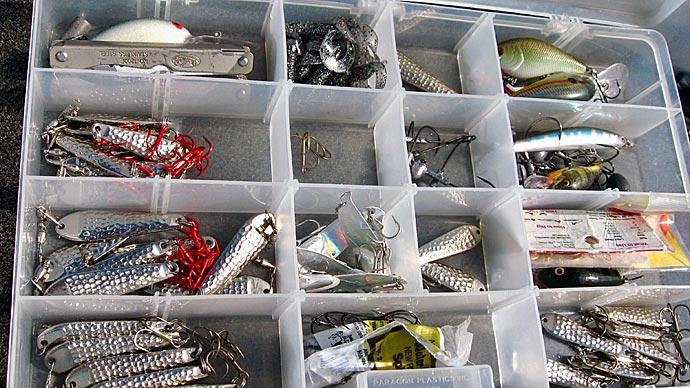
Today I’m going to talk about smaller spoons, which are different than the larger structure spoons that most people are familiar with. It’s a topic that doesn’t get talked about much.
This bait is good year-round. Please don’t assume it’s only a cold-water bait. I use it in winter, spring, summer, and fall. It’s an excellent all-around, all-season bait.
There’s been a revitalization of offshore use of spoons. Anglers are using 1/2 to 1 1/2 -ounce spoons on ledges and deep water instead of Carolina rigs. They’re an excellent imitation of dying fish. But there’s another aspect – smaller spoons. You work them similar to the big spoons. They imitate dying fish too but have an action like no other bait.
Spoons have an erratic flutter, and you can control the depth. These are crucial to success. It’s hard to get a crankbait down there deep, but you can reach it with a spoon and stay there.
There are two spoons I use in addition to my traditional spoons like the Hopkins and big structure spoons.
One is a little flutter spoon called the Little Cleo. Salmon and trout guys love it. It’s just a smaller version of the big spoons. It has a very pronounced wobble on the fall and the retrieve. On the retrieve, it has a very pronounced side-to-side action. When you drop it, you can feel it fluttering as it goes down; almost like that vibration you feel from a Rat-L-Trap. I like to use the Little Cleo when the fish are a little more aggressive when they want a little more action when feeding on baitfish.
I remember one tournament on Lay Lake. The water was frigid. I caught about eighty percent of my fish on grubs, but the other twenty percent came on a hair jig and a Little Cleo spoon. The baitfish were dying due to the cold water from the prior week, but it was warming up, and the fish were feeding on them. A dying baitfish kind of swims erratically and flutters up and down. I was able to imitate that to a “T” with the Little Cleo, and I caught some keeper fish.
There are two ways to fish it. When they’re shallow and schooling, I’ll cast out and slowly reel it back, pause and let it flutter, reel, pause, keeping my rod tip high. In deeper water (ledges, drops, etc.), snap your rod up and let it fall on a semi-slack line. You don’t want it to fall on a tight line, as it will take the wobble out. But on a slack line, you’ll never feel the bite. When you snap your rod from noon to the 3:00 position, it will maintain that wobble, and you’ll feel or see the bite.
Big spoons will work then, but you have to match the hatch. Those big spoons are for gizzard shad. Some lakes have threadfin or alewife, and the big ones only get two or three inches long. So the tiny bait works well.
I use both spinning and bait-casting gear, depending on the size of the spoon I’m using. I’ll use a seven-foot medium-heavy spinning rod for 1/8- to 1/4-ounce spoons. I’ll use baitcaster with 3/8- to 1/2-ounce spoons, with a 7-foot medium-heavy action rod.
Use fluorocarbon line with spoons. The dense sinking line gives the spoon a better action on the fall. Mono will deaden the action.
There are two ways I modify my spoons. One is to use a split ring or snap. That will help increase the action (flutter or side-to-side.) Another thing I do is to change the treble hook to one with a feather. I’ll use a VMC white, chartreuse, or red treble hook. That little bit of tackle can be that extra strike enticer, especially in clear water.
There are only three colors I carry: chrome, gold, white. You can cover almost every situation with these. You can add colors with dye on the white one.
Another spoon I throw is called a Kastmaster spoon. It’s what I call a cut slab spoon. It looks like a Hopkins, but it has two instead of having one surface on one side. It looks like a bagel roll with a slice down the side.
Use this when the fish are less aggressive - winter, after a cold front, or when they’re not in a chasing mood. It has a lot tighter wobble than the Cleo and is not as pronounced. You can feel it, but it’s a lot tighter. It’s like going from a wide-wiggle crankbait to a tighter-wiggle crankbait. It is perfect for when the fish are less aggressive.
I’ll use the same rods and reels, rear hook, and snap or split ring. But there’s one extra trick on this spoon that I won’t’ do on the Cleo because the Cleo will foul up. I’ll get a number eight treble hook (tiny) and put it right on the front of the split ring. You’d think you’d get hung up. Occasionally you will, but you usually won’t. I can’t tell you how many fish I catch on the front hook, but it works. You can only do it on the Kastmaster because it won’t get hung up.
When you want a bait with depth control - when they’re feeding on baitfish – those spoons are sleepers. I don’t know a better lure than spoons because of that wobble and flash. You can’t do that with a crankbait or Carolina rig. It’s perfect for imitating baitfish and shad.



